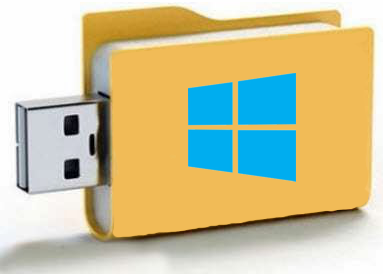Step-By-Step: Installing Windows 8.1 From A USB Key
Many manufactures are now creating ultra light and thin laptops and tablets to appease the masses in terms of desirable computing products. In order to achieve this however, the once valued DVD/CD-ROM and to be left out. There are many alternatives to installing Windows 8.1. Deployment can occur anywhere from network drives to USB enabled DVD/CD-ROMs. So why create a Step-By-Step to deploy an OS from a USB?
Many smaller companies are strapped for resources. IT administrators for these organizations require ingenuity to create solutions to adhere to their requirements of the company employees they support. Couple this Step-By-Step post with that with the relatively inexpensive cost of today's USB keys and you've got a viable solution to deploy Windows 8.1
Step 1: Install Windows ADK for Windows 8.1
- Download Windows ADK for Windows 8.1
- Install Windows ADK for Windows 8.1 on a IT Admin of lab workstation by running adksetup.exe
NOTE: Run the following command line: adksetup.exe /layout "C:\Setup\Windows ADK 8.1" should the desire be to download Windows ADK for Windows 8.1 only.
- Select the following components during the Windows ADK for Windows 8.1 setup:
- Deployment Tools
- Windows Pre-installation Environment (Windows PE)
- User State Migration Tool (USMT)
- Deployment Tools
Step 2: Install Microsoft Deployment Toolkit 2013
- Download Microsoft Deployment Toolkit 2013
- Install Microsoft Deployment Toolkit 2013 on the same IT Admin of lab workstation
Step 3: Creating a Deployment Share
- Run Deployment Workbench
- Right-click Deployment Shares and select New Deployment Share
- Select the following options in the New Deployment Share Wizard:
- Deployment share path: C:\MDTLab
- Share name: MDTLab$
- Deployment share description: MDT Lab
- Options: <default settings>
- Deployment share path: C:\MDTLab
Step 4: Import the Windows 8.1 OS
- Download the Windows 8.1 Enterprise x64 ISO
- Extract the ISO to the C:\Setup\Windows 8.1 Enterprise x64 folder. Create the folders should they not exist.
- In the Deployment Workbench, expand the Deployment Shares node.
- Expand MDT Lab, and select the Operating Systems node.
- Select Import Operating System.
- Select the following settings for the Import Operating System Wizard:
- Full set of source files
- Source directory: C:\Setup\Windows 8.1 Enterprise x64
- Destination directory name: WIN81X64
- Full set of source files
- After adding the OS, in the Operating System node, change the operating system name to Windows 8.1 Enterprise x64.
Step 5: Importing Necessary Applications
One of the advantages of utilizing MDT 2013 to create the image for the USB key is the ability to include drivers and / or applications that are specific to your organization's needs. In this example, Microsoft's Calculator Plus, will be added to this image. Feel free to customize it as you see fit.
- Download Microsoft Calculator Plus
- Copy CalcPlus.msi to C:\Setup\MSCalcPlus on the IT Admin of lab workstation.
- In the Deployment Workbench, in the MDT Lab node, select Applications.
- Right-click the Applications folder, and select New Application.
- Select the following settings to be used in the New Application Wizard:
- Application with source files
- Publisher: <blank>
- Application name: Microsoft Calculator Plus
- Version: <blank>
- Language: <blank>
- Source Directory: C:\Setup\MSCalcPlus
- Specify the name of the directory that should be created: Microsoft Calculator Plus
- Command Line: msiexec /I CalcPlus.msi /q
- Working directory: <default>
- Application with source files
Repeat this process as many time as required to include all the pertinent applications required.
Step 6: Create and Configure a Task Sequence
- Using the Deployment Workbench in the MDT Lab share, select the Task Sequences node.
- Right-click the Task Sequences node, and select New Task Sequence.
- Select the following settings for the New Task Sequence Wizard:
- Task sequence ID: W8-X64-001
- Task sequence name: Windows 8.1 Enterprise x64
- Task sequence comments: <blank>
- Template: Standard Client Task Sequence
- Select OS: Windows 8.1 Enterprise x64
- Specify Product Key: Do not specify a product key at this time
- FullName: CANITPRO
- Organization: CANITPRO
- Internet Explorer home page: https://www.canitpro.net
- Do not specify an Administrator password at this time
- Task sequence ID: W8-X64-001
Step 7: Create the Microsoft Deployment Toolkit 2013 Media
- In File Explorer, create the C:\MDTMedia folder.
- In the Deployment Workbench, via the MDT Lab / Advanced Configuration node, select the Media node.
- Right-click the Media node, and select New Media.
- Select the following settings within the New Media Wizard:
- Media path: C:\MDTMedia
- Selection profile: <default>
- Media path: C:\MDTMedia
- Open and edit the C:\MDTMedia\Content\Deploy\Control\Bootstrap.ini in Notepad, and in the Default section, add the SkipBDDWelcome=YES option. This will quicken the deployment by automating the welcome parts.
NOTE: Right-click the MEDIA001 media, select Properties, and clear either the x86 and x64 option depending on what you are deploying to avoid the selection of x86 and x64 boot images when starting the media (set by default).
- To create the media, right-click the MEDIA001 media, and select Update Media Content.
- Once completed, the Update Media Content process now generates the offline media in the C:\MDTMedia folder
- To create the bootable USB key, copy the content of the MDTMedia\Content folder to the root of the USB key.
- Next use diskpart to make the USB key active.
Once the steps above are completed, an IT professional can now utilize the newly created USB Key to deploy Windows 8.1.
While the drivers included with Windows 8.1 should suffice, additional drivers can be added to the USB key should the hardware being deployed to not be supported by default. Driver inclusion can be configured via MDT 2013 and will be included on a future post.
As mentioned earlier, there are a great deal of ways Windows 8.1 can be deployed. Learn more at Microsoft Virtual Academy .
